Alphatheta, often known as Pioneer DJ, has just dropped the XDJ-AZ, a highly anticipated all-in-one standalone DJ system boasting four decks within a single unit. After weeks of rumors swirling online, and having had the opportunity to test drive this unit myself, I’m ready to share the details, my first impressions, and my insights into how it performs for mixing. Standalone DJ gear is clearly taking center stage in today’s digital DJing world, so let’s dive into where the Pioneer Xdj-az fits within this dynamic market.
The XDJ-AZ: Delivering on the Promise of Four Decks
The Pioneer XDJ-AZ felt like an open secret from Alphatheta. Whispers first appeared on Reddit around two months prior to the announcement, which were then corroborated by industry insiders. I was fortunate enough to receive a unit for review just two weeks ago.
For years, I’ve personally longed for a four-deck mixing experience in a streamlined XDJ-RX format. The announcement of the XDJ-XZ left me somewhat wanting. While marketed as “four decks,” it essentially meant “four channels if you’re willing to use Rekordbox with your laptop.” The business strategy behind Rekordbox and DJ hardware is complex, but it felt like Pioneer DJ was hesitant to directly compete with their own flagship, high-end gear.
But now, Alphatheta has delivered the Pioneer XDJ-AZ. While they did provide a loaner for evaluation, this review is not sponsored. These are my genuine opinions. And yes, we will be stocking these in our store – consider pre-ordering through us to support a small business if you’re interested:
Preorder the Pioneer XDJ-AZ Now
Who Should Consider the Pioneer XDJ-AZ?
Let’s cut to the chase with some straightforward recommendations:
- If you crave seamless four-deck mixing in a standalone, club-ready format, the Pioneer XDJ-AZ is your answer. It’s genuinely enjoyable to mix on, fulfills its promises, and I predict it will become the flagship XDJ model in the coming years.
- If you’ve recently invested in another standalone system but desire true four-deck capability: Think about selling your current setup and upgrading to the Pioneer XDJ-AZ. Pioneer DJ gear typically holds its value well, but the optimal time to sell used gear is always sooner rather than later.
- If two decks are sufficient for your mixing style, the Pioneer XDJ-AZ might be more than you need.
Many of the XDJ-AZ’s strengths are built upon the successful foundation of the XDJ-XZ. The XZ has garnered a strong following for good reason, and the designers clearly recognized and incorporated those winning elements into this new release.
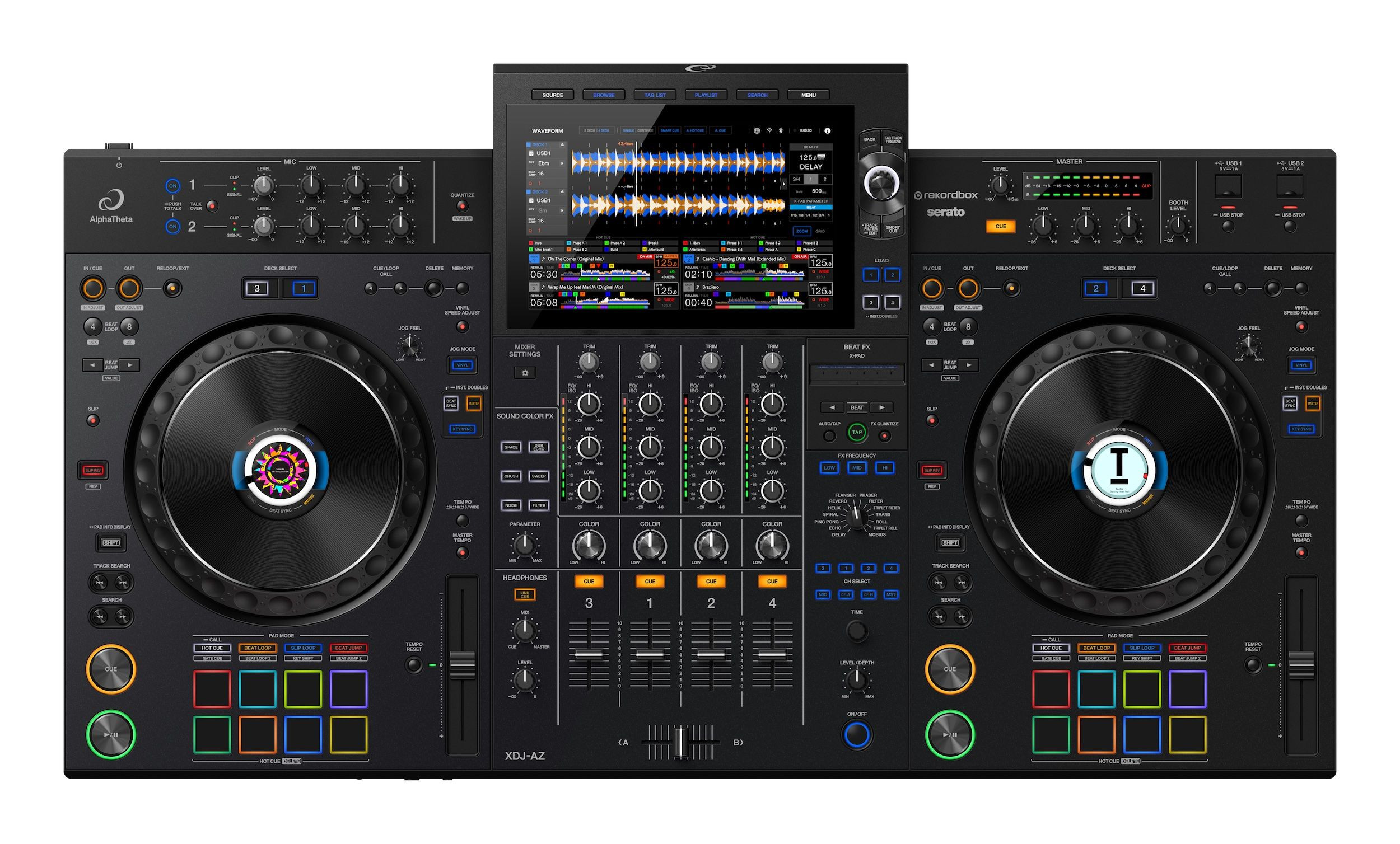 Top-down CGI image of the Pioneer XDJ-AZ showcasing its four decks and mixer layout.
Top-down CGI image of the Pioneer XDJ-AZ showcasing its four decks and mixer layout.
Standout Features of the Pioneer XDJ-AZ
- True Four Decks: The most significant feature is undoubtedly the four standalone decks. They operate intuitively and reliably. The deck controls utilize a “layer swap” system, where each side manages either decks 1/3 or 2/4. While some might argue that four decks are overkill for solo sets, the flexibility of a third deck is something most DJs can appreciate for creative mixing.
- Curious about the possibilities of more than two decks? Ean’s classic video “Mixing For The Stage” offers excellent insights.
- It’s worth noting the channel labeling: 3, 1, 2, 4 from left to right. This positions decks 1 and 2 in the central mixer area, mimicking a traditional two-deck setup, but might initially feel unconventional for those accustomed to a standard four CDJ and mixer configuration (typically channels 1, 2, 3, 4).
- Professional Setup Familiarity: The XDJ series’ appeal has always been its ability to bridge the gap to club-standard CDJ setups. The Pioneer XDJ-AZ continues this legacy by adopting many controls from the CDJ-3000, including the looping, beat jump, key sync, and the user interface and browse knob placement. This ensures a seamless transition for DJs moving between XDJ and CDJ environments.
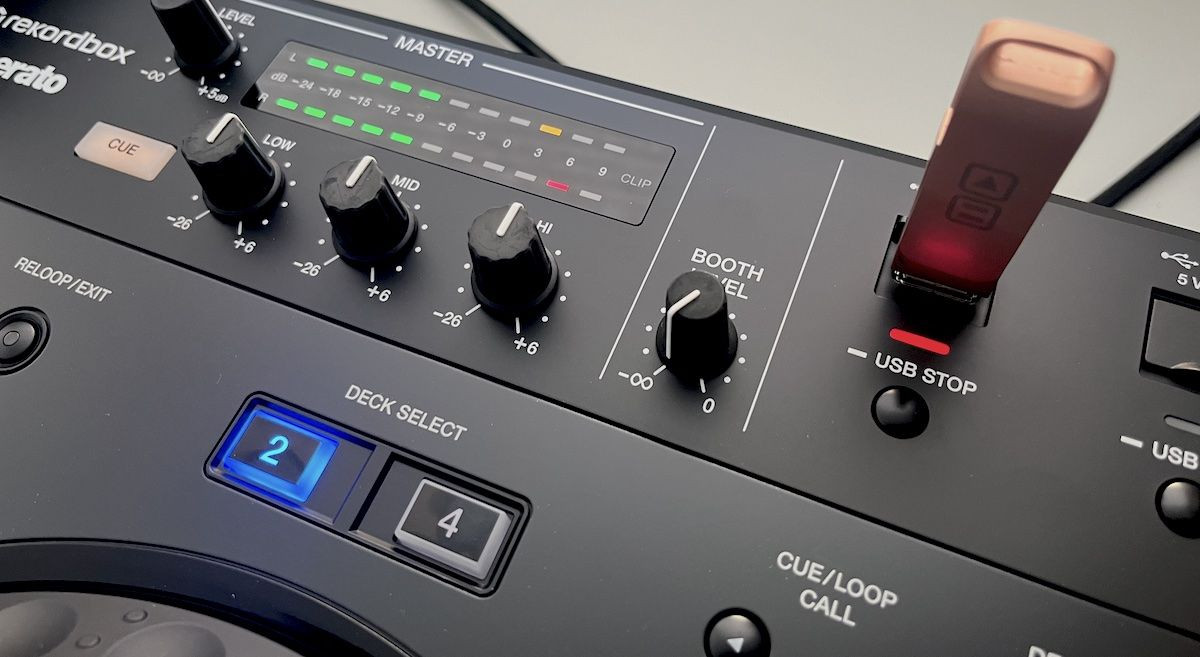 Close-up image of the Master Out section on the Pioneer XDJ-AZ highlighting the EQ knobs.
Close-up image of the Master Out section on the Pioneer XDJ-AZ highlighting the EQ knobs.
- Dedicated Master Out EQ/Isolator: A standout feature carried over from the XDJ-XZ is the master output EQ. This provides a quick and effective way to:
- Incorporate isolator-style mixing techniques for performance dynamics.
- Make broad EQ adjustments to compensate for basic PA systems lacking dedicated sound processing, especially in situations without a sound engineer.
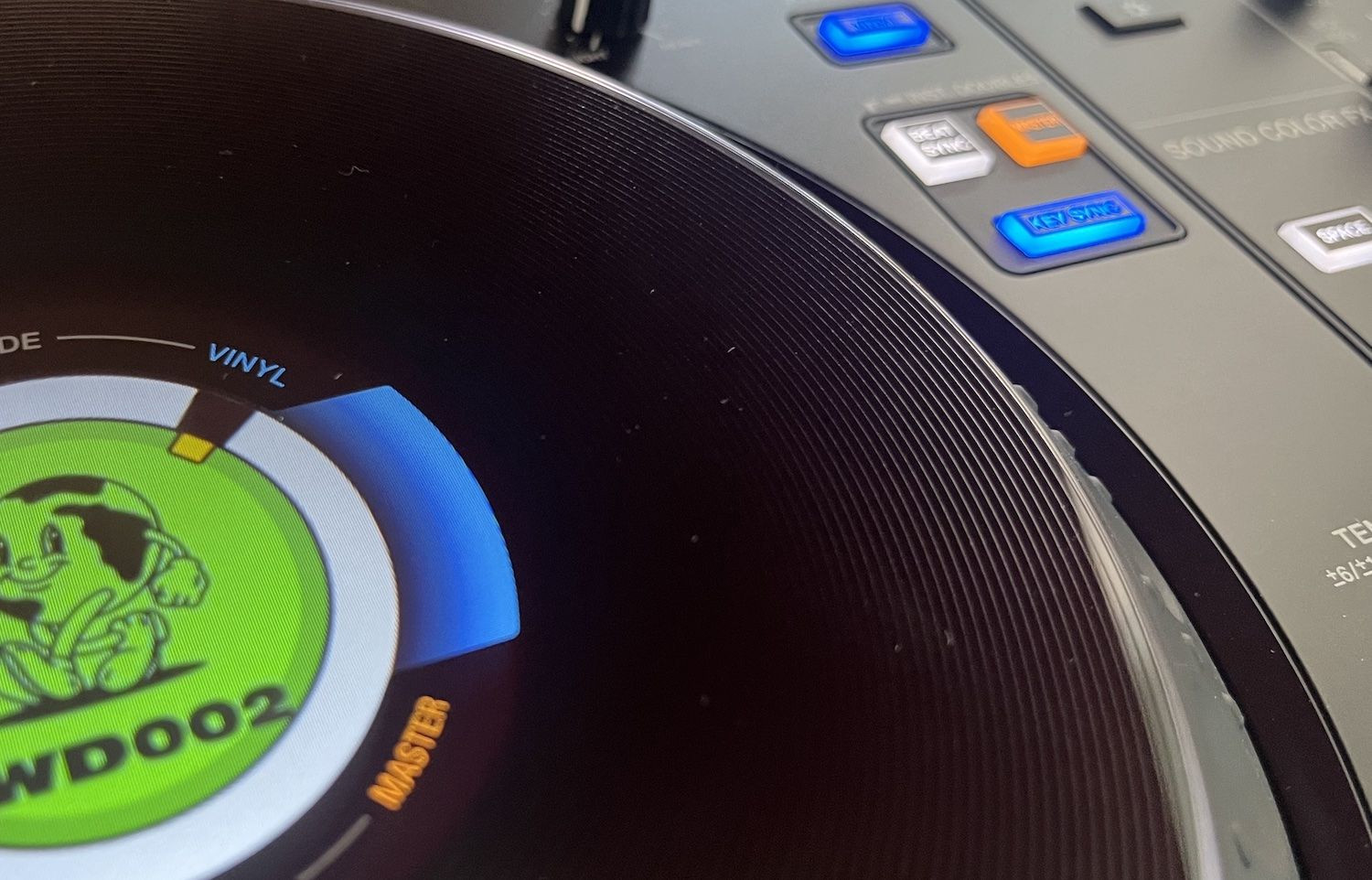 Angled close-up image of the Pioneer XDJ-AZ jogwheel showcasing its size and detail.
Angled close-up image of the Pioneer XDJ-AZ jogwheel showcasing its size and detail.
- Full-Size, Responsive Jogwheels: The Pioneer XDJ-AZ boasts full-size jogwheels with color displays, mirroring the feel and performance of CDJ-3000 jogwheels. They feature the same tension adjust and mechanical response, ensuring accurate and satisfying scratching and track manipulation, addressing a common critique of smaller jogwheels found on previous XDJ-R models.
Features with Question Marks
There are a couple of heavily promoted features on the Pioneer XDJ-AZ that I’m still evaluating:
- Cloud Direct Play with Beatport/Beatsource Streaming: Cloud-based music libraries are valuable as backups or for handling requests. However, I’ve yet to encounter DJs in typical performance settings (weddings, clubs, festivals, etc.) relying on streaming as their primary music source. While versatile source options are welcome, widespread adoption of cloud-only DJing seems unlikely in the near future, particularly given growing subscription fatigue.
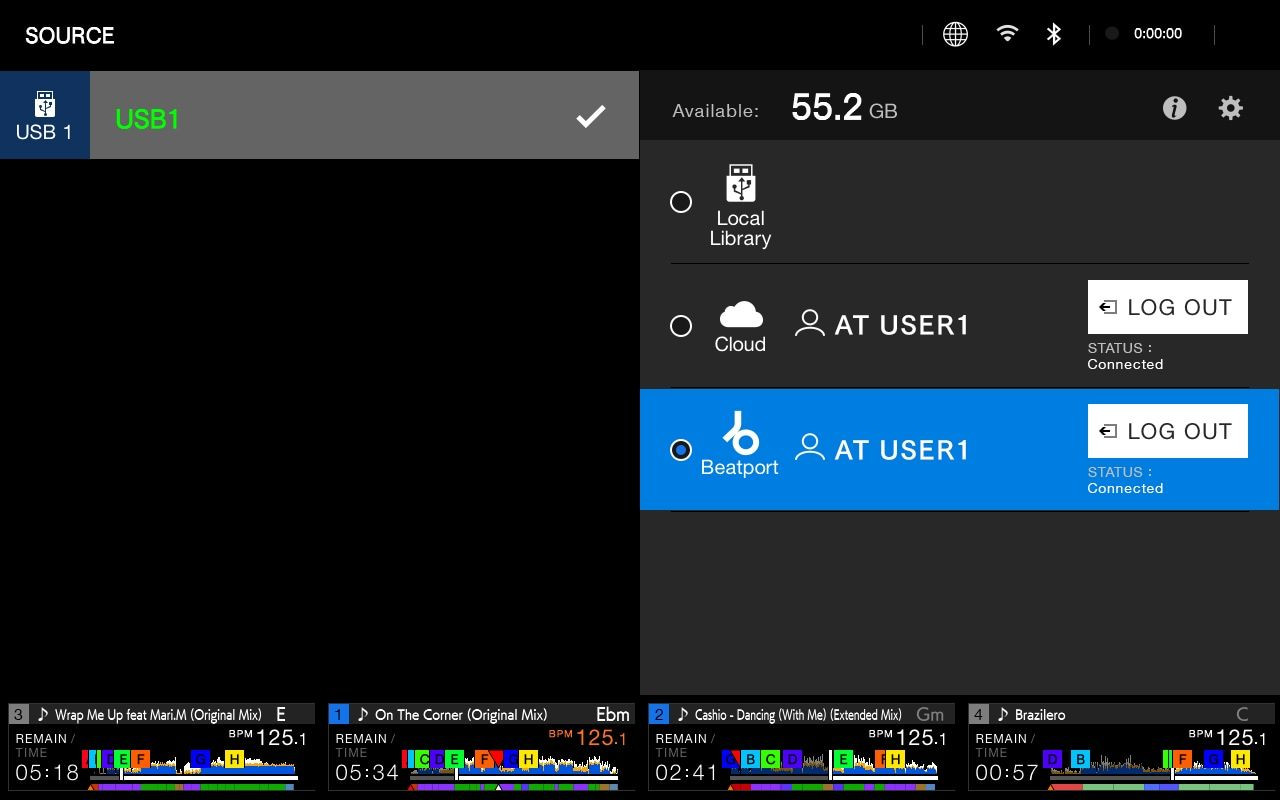 Image depicting the cloud library interface on the Pioneer XDJ-AZ screen.
Image depicting the cloud library interface on the Pioneer XDJ-AZ screen.
- SonicLink Wireless Headphone Connection: The integration of low-latency wireless audio in DJ gear is a positive step. However, I initially hoped this technology would prioritize main outputs, not headphones. Wireless connectivity for speakers like Soundboks or WaveEight, eliminating dongles, would be a significant advancement. Wireless headphones are convenient, but most DJs remain within a few feet of their decks while mixing, making the advantage less clear.
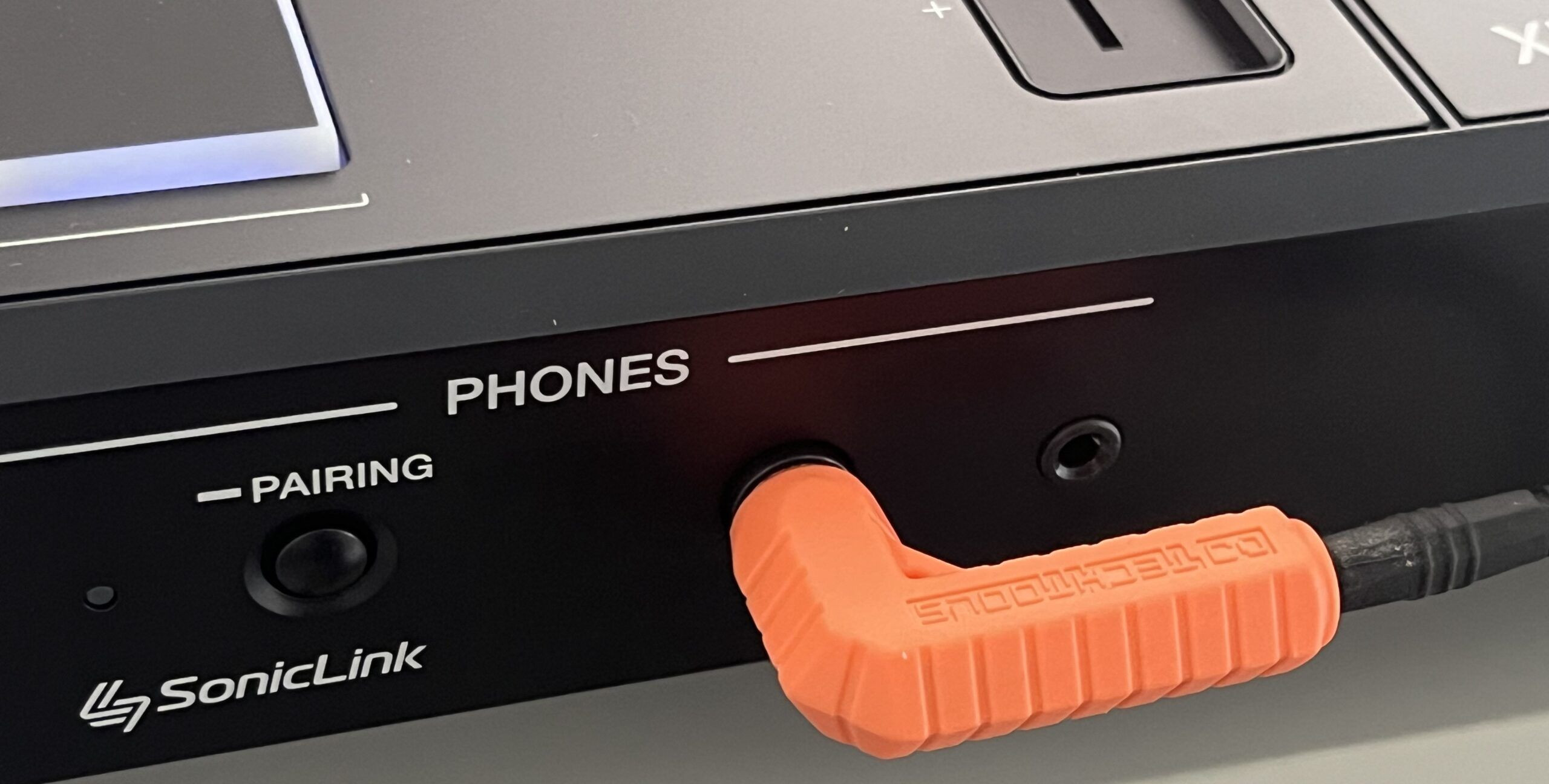 Close-up image of the headphone section on the XDJ-AZ, highlighting the SonicLink button.
Close-up image of the headphone section on the XDJ-AZ, highlighting the SonicLink button.
Areas for Improvement in the Pioneer XDJ-AZ
- Four-Deck Waveform Display: The current waveform display needs enhanced view modes optimized for four-deck mixing. This seems like a software update possibility, as Denon DJ effectively implemented multiple view modes on their Prime series. Currently, the four-deck view shows zoomed waveforms of the two active decks and waveform overviews for the others. A mode displaying all four zoomable waveforms simultaneously is essential for serious four-deck mixing.
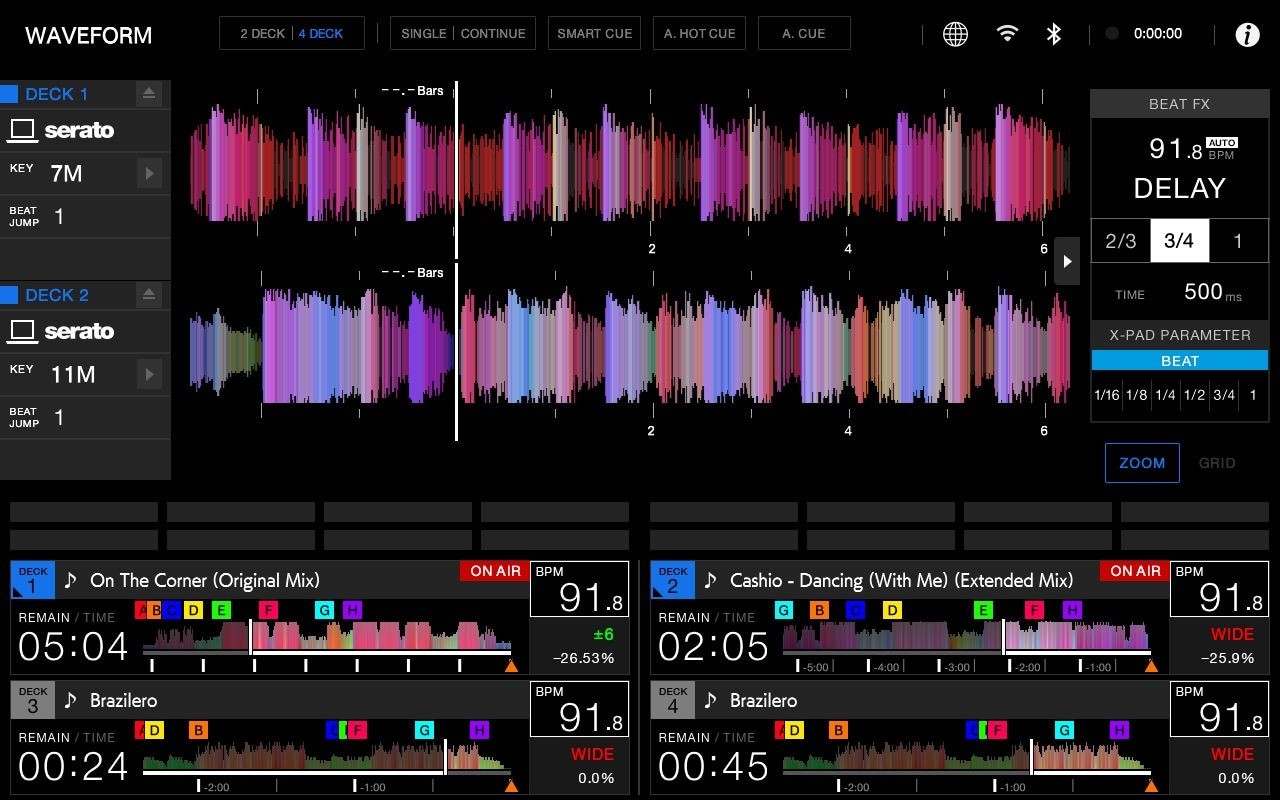 Screenshot of the Pioneer XDJ-AZ screen displaying the four-deck waveform in the current view mode.
Screenshot of the Pioneer XDJ-AZ screen displaying the four-deck waveform in the current view mode.
-
Performance Pad “Workflow Debt”: Alphatheta seems hesitant to remove legacy features from product lines, such as memory cues and CDJ mode on performance pads. These features can be confusing for new DJs. The performance pads on the XDJ-AZ feel like a relic from older DDJ controllers and don’t quite fit the high-end positioning of this unit. Consider replacing them with CDJ-3000 style cue buttons above the jogwheel, or fully commit to pad-based cue juggling by upgrading their functionality to match top-tier equipment.
-
“Mixer Settings” Button: This is a minor point, but the prominent “Mixer Settings” button raises questions. Its function, large text, and significant panel space are disproportionate to its likely use.
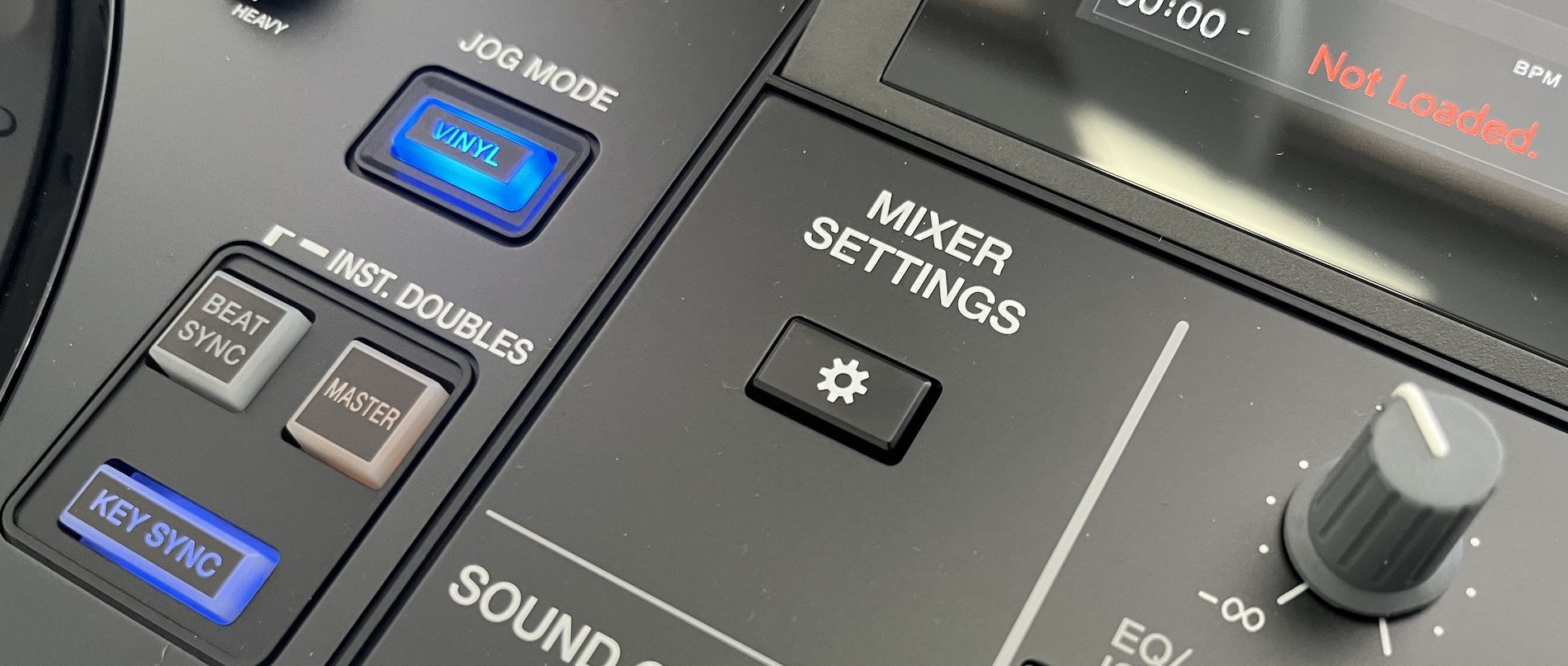 Image highlighting the "Mixer Settings" and Sync buttons on the Pioneer XDJ-AZ.
Image highlighting the "Mixer Settings" and Sync buttons on the Pioneer XDJ-AZ.
Pioneer XDJ-AZ Price Point
The Pioneer XDJ-AZ is priced at $3,199 (matching the Opus Quad’s current price). The economics are interesting. As with the Opus Quad, creating a unit too close to a four CDJ-3000 and DJM-A9 setup risks undermining sales of their flagship products. The $3,199 price seems strategically positioned from a business standpoint, although it will likely feel expensive for DJs not directly comparing it to a high-end CDJ/DJM system.
Hopefully, this price reflects a commitment to high-quality materials and components. XDJs endure considerable wear and tear (as evidenced by the photo of my XDJ-RX below), and long-term durability is crucial for users.
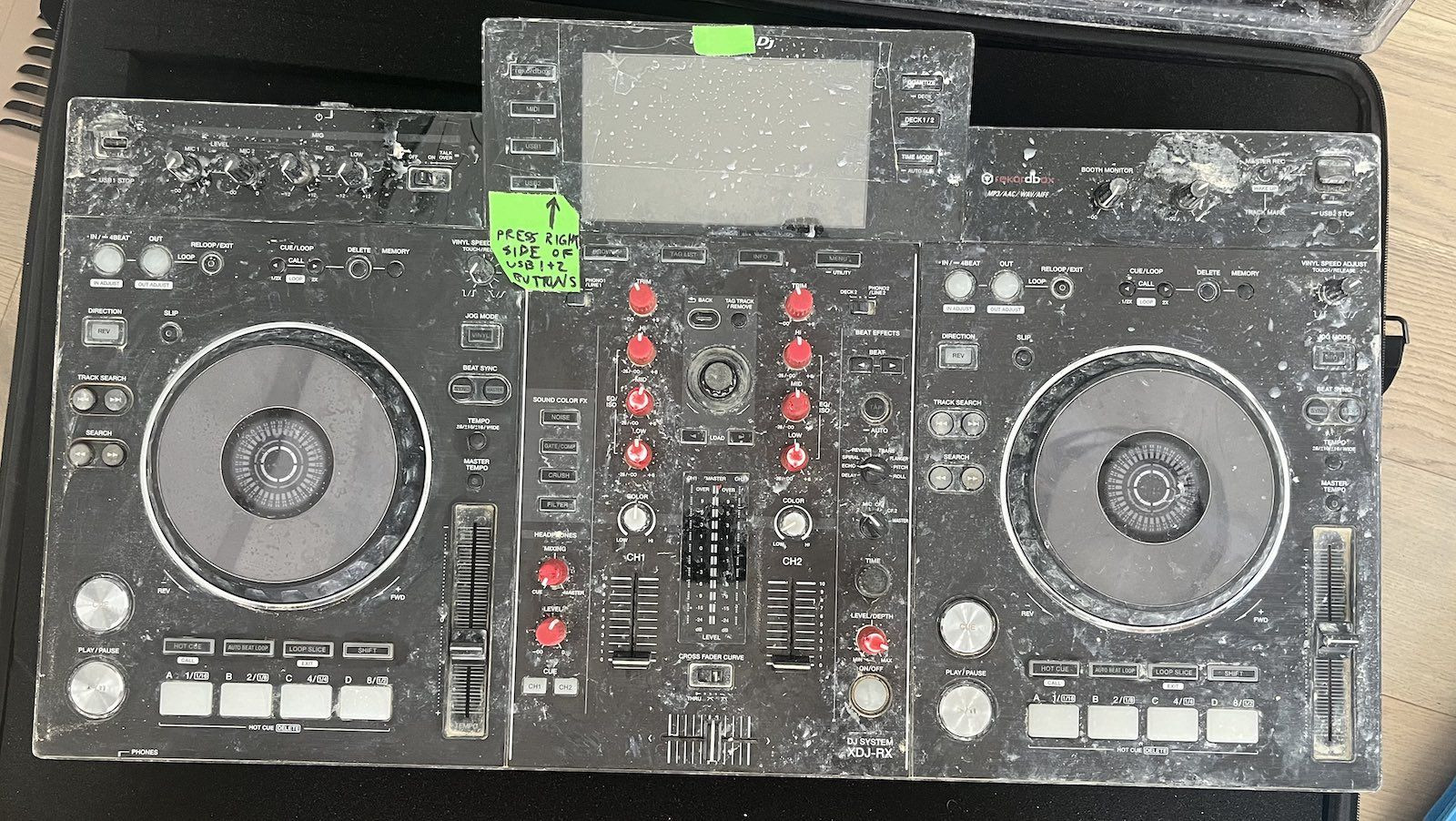 Image of a dusty and muddy XDJ-RX, showcasing its durability after heavy use.
Image of a dusty and muddy XDJ-RX, showcasing its durability after heavy use.
Pioneer XDJ-AZ vs. Opus Quad
The Opus Quad is an important comparison. Pioneer DJ launched the Opus Quad, their initial four-deck standalone, in March 2023. Its polarizing retro design sparked debate about its target audience.
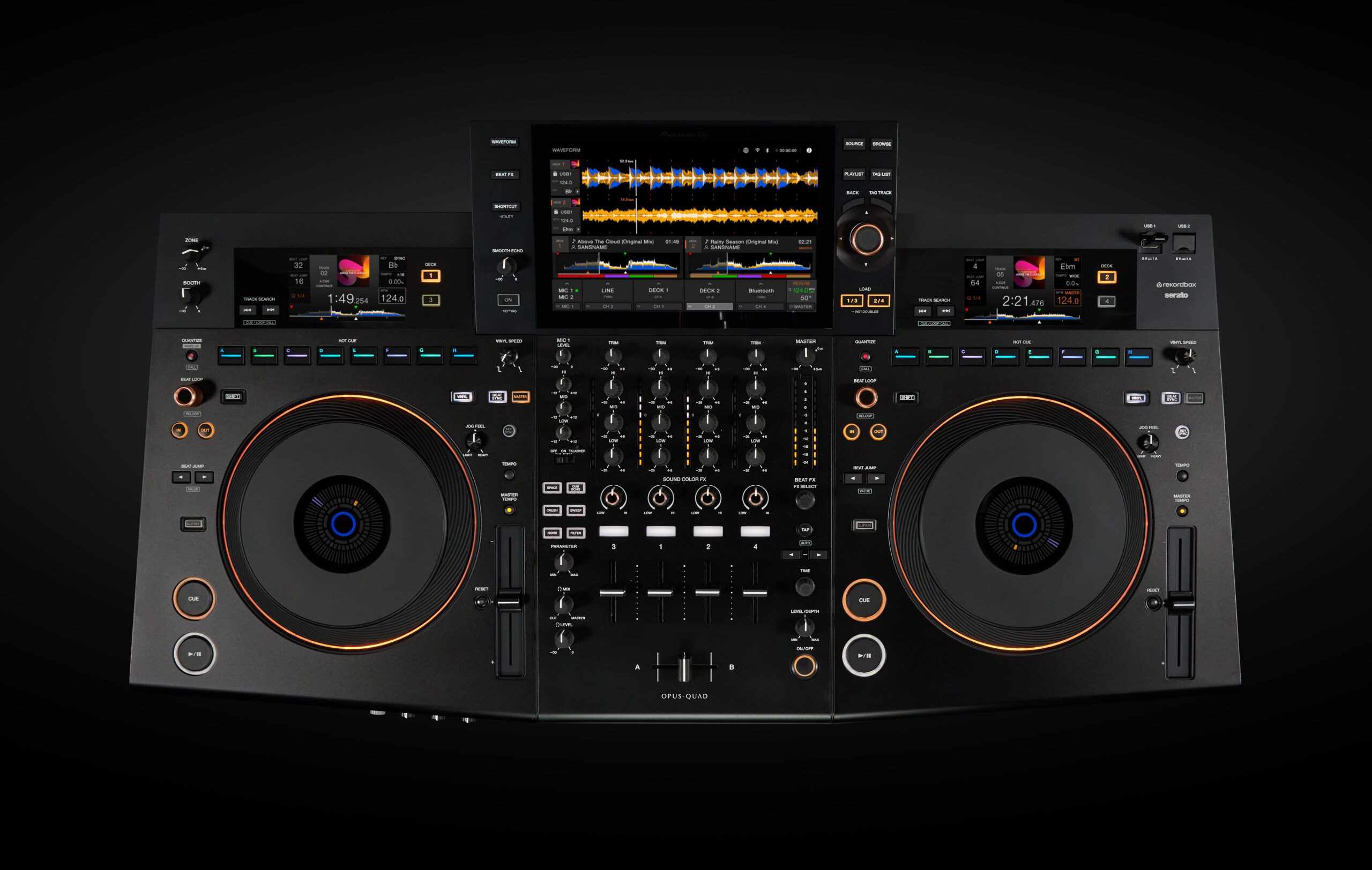 Lifestyle image of the Pioneer DJ Opus Quad in a home setting.
Lifestyle image of the Pioneer DJ Opus Quad in a home setting.
While the Opus Quad is a capable device, its layout and workflow prioritize aesthetics over established DJ practices. DJs familiar with XDJ/CDJ/DJM setups may find it less intuitive for on-the-fly use in performance settings. The XDJ series’ core appeal has been its cross-device familiarity, making the Opus Quad feel somewhat removed from Pioneer DJ’s typical user base.
Some DJs perceive the Opus Quad as more of a lifestyle product—emphasizing visual design over functional practicality. While the Opus Quad might be the visually striking option, the Pioneer XDJ-AZ appears to be the reliable workhorse, suggesting a potential divergence in Pioneer DJ’s product strategy.
A Saturated Rekordbox Standalone Market
The current Rekordbox standalone market is notably crowded. This trend arguably began with the XDJ-RR in 2018. The RR offered a slightly lower price point, a somewhat different design, and fewer features than the RX2, but with largely overlapping functionality.
Consider the current range of new Rekordbox-compatible all-in-one units:
And let’s not forget the XDJ-RX2, still a viable option on the used market.
This saturated lineup presents several challenges:
- High Prices: Reflecting current economic trends, all models are relatively expensive.
- Model Redundancy: Too many models offer very similar features.
- Premature Model Abandonment: Units seem to lack updates and features, possibly to differentiate price points.
Hopefully, Alphatheta will streamline their offerings in the coming years, reducing model overlap. Is such a wide array of all-in-one units, each with minor variations in features, components, firmware, workflows, and interfaces, truly necessary from a single manufacturer?
Final Verdict: Standalone DJing and the Pioneer XDJ-AZ
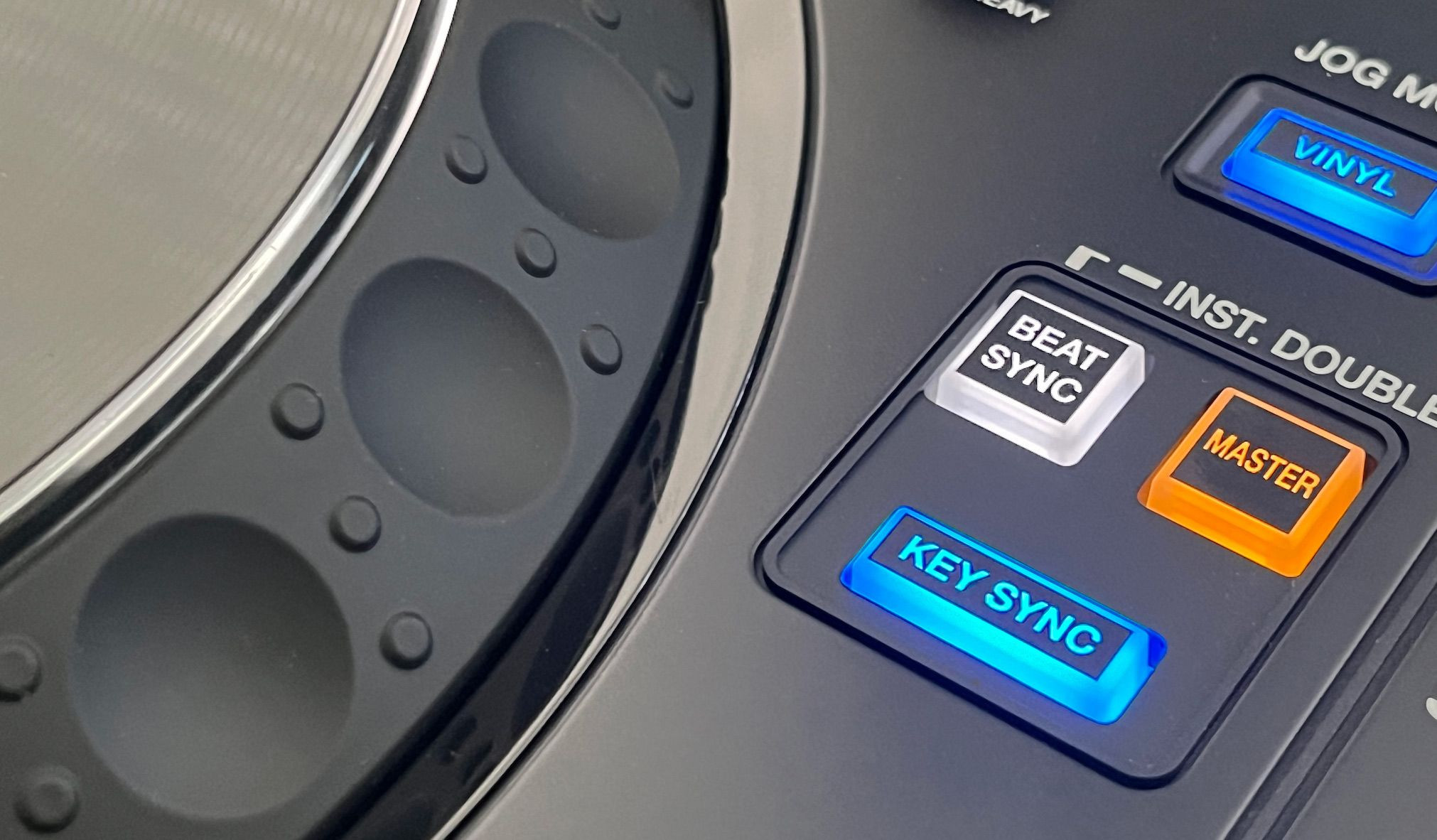 Close-up image of the Pioneer XDJ-AZ jogwheel with the sync button illuminated.
Close-up image of the Pioneer XDJ-AZ jogwheel with the sync button illuminated.
I’m personally excited to incorporate four-deck mixing more regularly, knowing the Pioneer XDJ-AZ will make this option more accessible in various venues.
The popularity of the XDJ series at smaller events has, in recent years, somewhat diminished the need to practice with more than two decks. Why bother if the option isn’t readily available? Most DJs adapt to the equipment provided, or bring their own.
The promise of four-deck mixing, evident in the controller revolution of a decade ago with the Kontrol S4 and DDJ-SX, is finally realized in a meaningful way within the Rekordbox ecosystem with the Pioneer XDJ-AZ.
Preorder your Pioneer XDJ-AZ here to support DJ TechTools: Preorder Link. Looking for a superior USB drive? Sign up here for updates!
Tags: alphathetafour deckfour deck mixingrekordboxxdj-az
